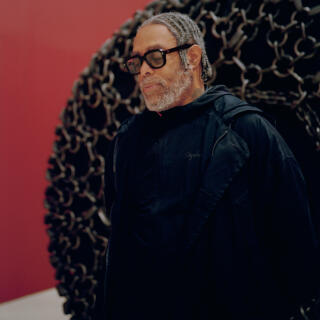We expected to interview a person. Arthur Jafa, his face framed by short braids, meets us with an ardent gaze and his deliberately lyrical way of speaking.
"A human being, male, Black, yes, of course," he said, describing himself, when we meet him at the Luma Foundation in Arles. Then come these disturbing words, delivered in his southern accent: "Deep down, I feel more like a thing." Is it provocation or self-deprecation? Arthur Jafa's (pronounced "jay-fah") thinking is too complex to be so simple. He's a thing − really?
Highly respected in the film world, "AJ," as he is known, has always eluded definition. After serving as director of photography on Julie Dash's film Daughters of the Dust, which earned him the 1991 Sundance Film Festival Best Cinematography Award, and then Spike Lee's Crooklyn in 1994, he is now celebrated in museums around the world as an icon for the generation of African-Americans who rose up in the Black Lives Matter movement.
Leaving viewers speechless
Set to the rhythmic flow of Kanye West and his Ultralight Beam, his video Love is the Message, the Message is Death (2016) offers itself as a crystallization of that generation’s anger. His exhibition in Arles, his first retrospective in France, leaves viewers speechless. Sculptures and videos storm the mind and senses, constructing a dazzling journey through the imagery and thought of Black America. He warns, though, that "I try to make works that are more interesting than mere political manifestos, offered for interpretation. I like works that have an open ending, because Black identity is an open ending.”
"The bolis have a physical part, the one we see and which enters the three dimensions of our existence; but they also have a metaphysical part. They are a portal." Arthur Jafa
So a thing, always? To help explain, the artist takes Le Monde to a somewhat secret room in the heart of the Luma hangar. It shelters objects he did not create. On a pedestal, three vaguely animal figures appear: roughly contoured quadrupeds with humps. They seem to be carved out of mud. "Of the ground, blood, pig shit," the artist specified. They are bolis from Mali, ritual objects that the Bambara people believe are endowed with magical powers.
"I'm obsessed with these objects," he said. "the first time I saw them was in a New York gallery in 1998. As soon as I walked in, they had an incredible effect on me. I went back to see the exhibition six times, because I wanted to understand if I was in a particular mood during the first visit that would have explained my emotion." But each time, the sculptures affected him deeply. "They don't just have an effect on your psyche, no! They have a real power, like a piece of uranium," he said. He has made them his exhibition’s reactor core. Mr. Jafa is convinced that "the bolis have a physical part, the one we see and which enters the three dimensions of our existence; but they also have a metaphysical part. They are a portal. Like icebergs, the most important part is under the surface."
You have 60.72% of this article left to read. The rest is for subscribers only.
